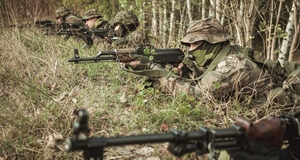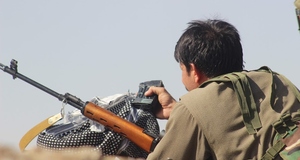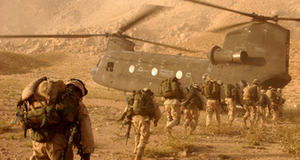From Clocks and Clouds VOL. 7 NO. 1Reevaluating Military Strategy: The Effectiveness Of Conventional DeterrenceResultsConducting the testing of this research first involved the integration of various prevalent data into one unified dataset. As stated previously, this involved using the International Crisis Behavior Version 10.0 as the foundation within the model. Then, an addition of all non-conflict years was plugged into the existing country cases that had been involved in at least one conflict between 1950-2001. Finally, the U.S. troop data was incorporated into the dataset with their corresponding countries and years. In order to make U.S. troop data more significant within the model, it was ideal to transform the data into categorical sub-covariates. With these, the model can test each individual variable, and more accurately test which holds a significant relationship with the status (conflict). Once the data were integrated, the testing for hazard could begin. The test was conducted in IBM SPSS's Cox Proportional Hazard Regression model. The time variable used was "time since last crisis trigger," the status variable was crisis (1) or no crisis (0) in order to select which events would be used, and the covariate pattern was U.S. troops split into six categorical variables. The criteria for significance to deny the null hypothesis was a 95% curve, or a p-value=.05. Out of a total of 6805 cases, 553 (8.1%) crisis events were available for analysis with none censored and the rest dropped for incompatibility with the model. The first analysis was to determine whether the model with the covariates demonstrates a relationship to the overall model, and was significant enough to reject the null hypothesis. Referring to Table 1.0, the difference between -2log likelihood without covariates in the model and the -2log likelihood with the covariates resulted in a Chi-Square value of 11.152. With a df of 5, the critical value was .048, less than p=.05. This shows that the model is significant enough to reject the null hypothesis.Since the model is significant enough to use with the given covariates, the research advanced with observing the different ratios of hazard associated with each category of troop levels and whether they were significant. Referring to Table 1.1, we can see that U.S. troop variables, with a df of 5, are significant at .051, close to the p-value of .05. For this research's purpose, it will continue to find this significant, as it is relatively close, but should be noted with an air of caution. When the variables are furthered analyzed, it can be noted that US troops (2) of 50-100 troops and (5) of 1000+ troops demonstrate significance under p-value=.05. These two variables also show 95.0% confidence interval without including 1, suggesting that there is a difference in hazard. For conflict zones with US troops between 51-100, the hazard ratio is .762 times more likely to cause another conflict than without troops present. In other words, instances with troop levels between 51-100 pose a 24% decrease in risk to conflict eruption compared to non-troop conflicts. Even more interesting is that having 1001+ troops present has a hazard ratio of being .549 times more likely for a conflict to occur than without troops, also considered a 46% reduction in risk compared to conflicts without troops. Interestingly enough, this trend of reduction in risk occurs with all levels of troop presence; however, for variables (1), (3), and (4), the p-value was not statistically significant and the 95% confidence interval for the hazard ratio included 1, suggesting no difference in risk compared to no troops. Overall, there is a proportional level of hazard that is attributed to troop presence on conflict occurrence. As shown with Figure 1.0, the lines of the two significant variables are about standard to each other. These results can be interpreted into two different ideas: the presence of troops does have a risk-reducing effect on conflict occurrence, and relative small-scale or large-scale troop presence have varying reduction capabilities. The first idea supports the general idea that conventional deterrence does reduce the chance for conflict outbreak or escalation. This would be supportive of Huth's argument of the importance of forward deployed troops in deterring the situation between the aggressor and the defender (Huth 1988). This would make for a compelling argument; however, three out of the five variables showed no sign of statistical significance. The two variables (2) and (5) that did show statistical significance do leave room for interpretation of the importance that U.S. troops play in conflicts. Given that Figure 1.0 highlights the risk-ratio line for no troop presence as being relatively equal to the lines of variables 2 and 5, the strength of their risk-reduction should be questioned. The interpretation of these results finds that the presence of troops does have an overall effect on reducing the chance for a future conflict to occur. It goes without saying that there is room for possible error during the testing of this data. One possible error would be an incorrect assumption of proportionality for the model. It is assumed with conducting this test that the covariant of U.S. troops does not change over time. This research has attempted to control this by constructing a controlled time variable that can apply constituently for all designated events, while also splitting the original covariate into categorical sub-variables. Another possible conflict with the research is not also conducting non-proportional hazard model tests on the data. Due to time constraints of this research, it would be wise to further test the data in non-proportional models like the log-rank test. This would confirm the effectiveness of using a proportional hazard test for this specific use of data. ConclusionGiven the findings of the cox regression hazard test of U.S. troops presence in conflicts, this research concludes that troops do have a risk reducing effect on preventing future conflicts from occurring. The risk reduction of conflict eruption by troops can be analyzed as effective deterrence in the prevention of future conflicts within a given country. This is similar to the findings previously conducted by Huth and Quakenbush, that military flexing in conflict situations does reveal a trend of successful conventional deterrence. It can also be inferred that if this trend works for the deployment and stationing of troops on the ground, then it may also be applicable to all forward deployed forces, including naval and air forces. Furthermore, this is a confirmation of the U.S.'s continued support of its allies through military stations in conflict regions in order to reduce the overall risk of conflict escalation. Much of the data supported this argument for the United States' troop presence in Europe and Asia, for the overall length between conflict occurrences. This is further parallel to the general realist paradigm of conventional deterrence, where a show of force by a more militarily superior country against weaker countries is effective. This research does not attempt to answer the complex question of conventional deterrence; however, it does contribute to the argument that military presence in conflictridden areas does work. Future research that would build upon this research would be an analysis of forward deployment naval units and naval exercises' proximity in relation to conflict areas. Michael Gerson's and Daniel Whiteneck's overview research of the navy's role in conventional deterrence is an excellent starting point in incorporating maritime power; however, what their research is lacking is the comprehensive testing of naval data as my research does with ground troops (Gerson and Whiteneck 2009). This additional testing can further strengthen the argument either for or against the effectiveness of conventional deterrence whatever the results may be. As the global political dynamic continues to change and new conflicts begin to escalate, it would be in the general interest for the United States and regional military alliances like NATO and EUCOM to deploy their forces earlier into conflict escalation zones. It would also be in their best interest to retain some manageable force level in these conflict zones after the initial escalation in order to prevent future conflicts, as this research has shown. AuthorDan Fitzgerald is a student of International Studies and Economics. He graduates in December of 2017. School of International Service (SIS) and College of Arts & Sciences (CAS), American University. Email: df2310a@student.american.edu AcknowledgementsI would like to thank Dr. Joseph Young, Dr. Thomas Zeitzoff, and Dr. Benjamin Jensen of American University for all of their comments and support throughout this research. I would also like to thank the School of Public Affairs for providing me with the funds to produce this research through the Peace and Violence Research Lab Fellowship. ReferencesAronson, Shlomo. 2009. "Israel's Security and the Holocaust: Lessons Learned, but Existential Fears Continue." Israel Studies 14 (1): 65–93. Beattie, Troy. 2010. "Conventional Deterrence and the Falkland Islands Conflict." MA diss., Naval Postgraduate School. Blackwell, James. Summer 2011. "Deterrence at the Operational Level of War." Strategic Studies Quarterly 5 (2): 30-51. Box-Steffensmeier, Janet and Christopher Zorn. Apr. 1998. "Duration Models and Proportional Hazards in Political Science." Annual Meeting of the Midwest Political Science Association 1 (9): 1-32. Box-Steffensmeir, Janet M., Dan Reiter, and Christopher Zorn. 2003. "Non-proportional Hazards and Event History Analysis in International Relations." Journal of Conflict Resolution 47 (1): 33-53. Brecher, Michael and Jonathan Wilkenfeld. 2000. A Study of Crisis. Ann Arbor: University of Michigan Press. Brecher, Michael, Jonathan Wilkenfeld, Kyle Beardsley, Patrick James, and David Quinn. 2016. International Crisis Behavior Data Codebook, Version 11. Buchan, Alastair. 1962. "The Reform of NATO." Foreign Affairs 40 (2): 165–82. Coleman, Kevin G. 2012. "Aggression in Cyberspace." In Conflict and Cooperation in the Global Commons: A Comprehensive Approach for International Security, edited by Scott Jasper, 105-20. Washington: Georgetown University Press. Danilovic, Vesna. 2001. "Conceptual and Selection Bias Issues in Deterrence." Journal of Conflict Resolution 45 (1): 97–125. Ferguson, Niall. Jan.-Feb. 2003. "Power." Foreign Policy 134: 18-22. French, Erik D. 2014. "Motivated Reasoning in U.S.-China Deterrence and Reassurance Past, Present, and Future." Strategic Studies Quarterly 8 (4): 71-94. Gerson, Michael and Daniel Whiteneck. Mar. 2009. Deterrence and Influence: The Navy's Role in Preventing War. CRMD0019315.A4/1Rev. Arlington: The Center for Naval Analyses: 1-76. Ghosn, Faten, Glenn Palmer, and Stuart A. Bremer. 2004. "The MID3 Data Set, 1993—2001." Conflict Management and Peace Science 21 (2): 133–54. Goodman, Julie E., and Juhi K. Chandalia. 2010. Comments on the Use of the Cox Proportional Hazards Model to Assess the Association Between Air Pollutant Exposure and Health Effects in Semi-Ecological Studies. Rep. no. 2010–19415. Cambridge: Gradient. Harvey, Frank P. 1998. "Rigor Mortis or Rigor, More Tests: Necessity, Sufficiency, and Deterrence Logic." International Studies Quarterly 42 (4): 675-707. Harvey, Frank. Dec. 1999. "Practicing Coercion: Revisiting Successes and Failures Using Boolean Logic and Comparative Methods." Journal of Conflict Resolution 43 (6): 840-71. Huntington, Samuel. Winter 1983-1984. "Conventional Deterrence and Conventional Retaliation in Europe." International Security 8 (3): 32-56. Huth, Paul. 1988. Extended Deterrence and the Prevention of War. New Haven: Yale University Press. Huth, Paul and Bruce Russett. 1990. "Testing Deterrence Theory: Rigor Makes a Difference." World Politics 42 (4): 466–501. Huth, Paul, Christopher Gelpi and D. Scott Bennett. Sep. 1993. "The Escalation of Great Power and Militarized Disputes: Testing Rational Deterrence Theory and Structural Realism." The American Political Science Review 87 (3): 609-623. Ladwig III, Walter C. May 2015. "Indian Military Modernization and Conventional Deterrence in South Asia." Journal of Strategic Studies 38 (5): 1-44. Department of the Army. Leadership Statements and Quotes. Washington: Department of the Army, 1985. Lebow, Richard Ned and Janice Gross Stein. 1990. "Deterrence: The Elusive Dependent Variable." World Politics 42 (3): 336–69. Mearsheimer, John J. 1983. Conventional Deterrence. Ithaca: Cornell University Press. Monten, Jonathan. "Thucydides and Modern Realism." 2006. International Studies Quarterly 50 (1): 3-25. Morgenthau, Hans J. 1978. Politics Among Nations: The Struggle for Power and Peace. Fifth edition, Revised. New York: Alfred A. Knopf, Inc. Payne, Keith. 2001. The Fallacies of Cold War Deterrence and a New Direction. First edition. Lexington: University Press of Kentucky. Quackenbush, Stephen. 2010. "General Deterrence and International Conflict: Testing Perfect Deterrence Theory." International Interactions 36 (1): 60-85. Smith, Derek. 2014. "Deterrence and Counterproliferation in an Age of Weapons of Mass Destruction." PhD diss. Somerville College, University of Oxford. Smith, Besa, and Tyler Smith. 2000. Survival Analysis and the Application of Cox's Proportional Hazards Modeling Using SAS. Publication no. 244-26. San Diego: Department of Defense Center for Deployment Health Research. Soloman, Jonathan. Winter 2013. "Demystifying Conventional Deterrence: Great-Power Conflict and East Asian Peace." Strategic Studies Quarterly 7 (4): 117-57. Thränert, Oliver, and Kerry M. Kartchner. 2015. "From Offense to Defense? Extended Deterrence and Missile Defense." In The Future of Extended Deterrence: The United States, NATO, and Beyond, edited by Stéfanie von Hltaky and Andreas Wenger, 15598. Washington: Georgetown University Press. United States Department of Defense Fiscal Year 2017 Budget Report. Washington: Office of the Under Secretary of Defense (Comptroller) Chief Financial Officer, 2016. Wilner, Alex. 2015. Deterring Rational Fanatics. Philadelphia: University of Pennsylvania Press. Zagare, Frank C. 1990. "Rationality and Deterrence." World Politics 42 (2): 238–60. Suggested Reading from Inquiries Journal
Inquiries Journal provides undergraduate and graduate students around the world a platform for the wide dissemination of academic work over a range of core disciplines. Representing the work of students from hundreds of institutions around the globe, Inquiries Journal's large database of academic articles is completely free. Learn more | Blog | Submit Latest in Political Science |





















